Advanced Dental Care
Corrective Jaw Surgery
Corrective jaw surgery moves your teeth and jaws into positions that are more balanced, functional, and healthy. Whether your needs include improving your bite and function, appearance, or speech, corrective jaw surgery can have a dramatic and positive effect on your outlook on life. We are here to work together with you to help you achieve a beautiful, functional, pain-free smile that will last for the rest of your life.
Who needs corrective jaw surgery?
In some cases, your upper and lower jaws may have grown at different rates. Injuries and birth defects may also affect jaw alignment. While orthodontics can usually correct problems when only the teeth are misaligned, corrective jaw surgery may be necessary to correct misalignment of the jaws. If you suffer from any of the following conditions, you may be an excellent candidate for corrective jaw surgery:
- Difficulty chewing, biting food, or swallowing
- Chronic jaw or jaw joint (TMJ) pain and headache
- Excessive wear of the teeth
- Open bite (space between the upper and lower teeth when the mouth is closed)
- Unbalanced facial appearance from the front or side
- Facial injury or birth defects
- Receding chin
- Protruding jaw
- Inability to make the lips meet without straining
- Chronic mouth breathing and dry mouth
- Sleep apnea (breathing problems when sleeping, including snoring)
Receiving treatment to correct any of the above conditions is a commitment, not only to your health, but to your happiness as well. While treatment, which may include surgery and orthodontic treatment, may take several years to complete, the results will last a lifetime. There is no reason to live with painful, uncomfortable jaw conditions. Contact our office to learn about the best treatment option for you, your needs, and your smile.
Impacted Canines
An impacted tooth is a tooth that is blocked or “stuck” underneath the gum line and does not erupt into its correct position on its own. Most often, an impacted tooth will be a third molar, or wisdom tooth, though it is a common occurrence in canine teeth as well. Canine teeth are located at the corners of the arch, next to the incisors. They have one pointed edge (cusp) which is used for holding, grasping, and tearing food. Because of the canine’s long root, they are very strong, stable teeth. Canines are usually the last teeth to erupt and usually do so when your child is around the age of 12 or 13.
The American Association of Orthodontists recommends that children have an orthodontic examination by the age of seven, which allows us the opportunity to monitor your child’s teeth eruption and detect impactions early.
If your child does develop an impacted canine, a simple surgical procedure is recommended to assist in the eruption of the tooth. We will surgically expose the tooth by cutting a small flap in the surrounding gum. After the tooth is exposed, we will either leave the tooth to erupt on its own or attach an orthodontic bracket to the tooth to help guide its descent. With early detection and combined surgical and orthodontic treatment, impacted canines can be allowed to erupt and/or be guided to the ideal position in your child’s mouth.
Palatal Expander
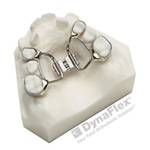 The palatal expander "expands" (or widens) your upper jaw by putting gentle pressure on your upper molars each time an adjustment is made. The animation below will instruct you about when and how to adjust your expander. When you achieve the desired expansion, you will wear the appliance for several months to solidify the expansion and to prevent regression.
The palatal expander "expands" (or widens) your upper jaw by putting gentle pressure on your upper molars each time an adjustment is made. The animation below will instruct you about when and how to adjust your expander. When you achieve the desired expansion, you will wear the appliance for several months to solidify the expansion and to prevent regression.
Adjusting the palatal expander
You can also download these instructions in a printable PDF document.
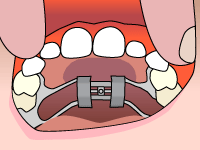
Step 1
In a well-lit area, tip the patient's head back.
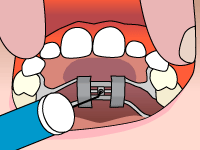
Step 2
Place the key in the hole until it is firmly in place.
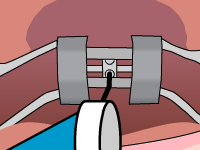
Step 3
Push the key toward the back of the mouth. You will notice the fender will rotate and the new hole will appear. The rotation stops when the key meets the back of the expander.
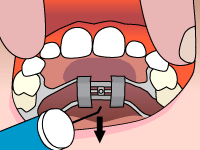
Step 4
Press back and down toward the tongue to remove the key. The next hole for insertion of the key should now be visible.
